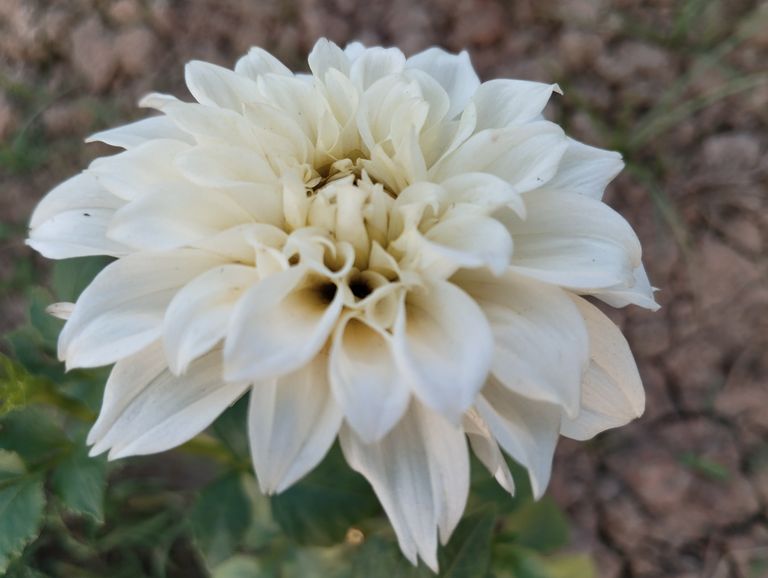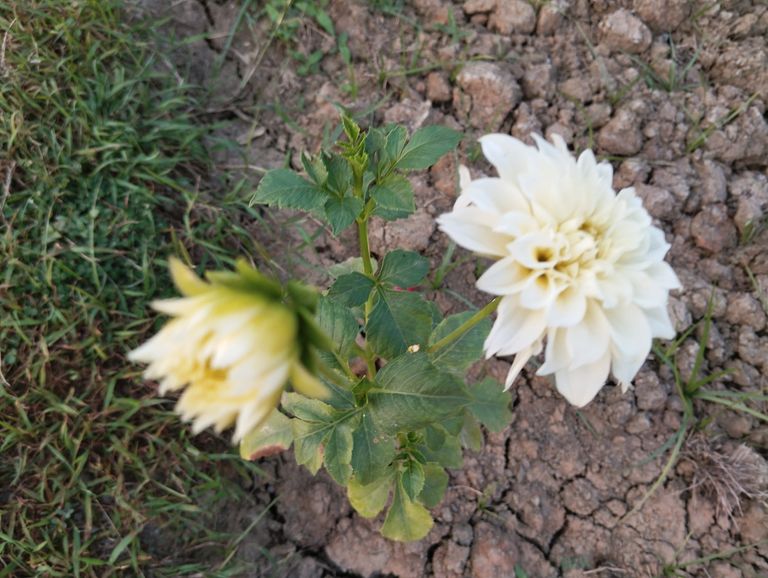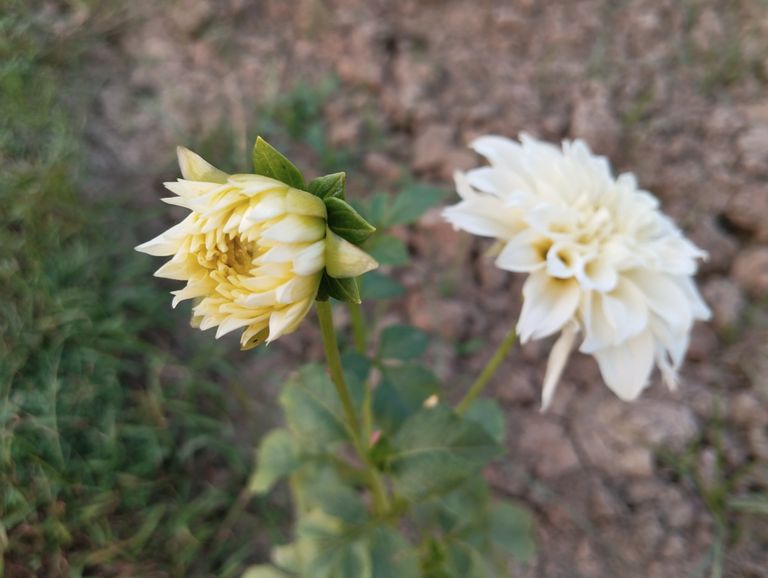
Dahlia Flower Cultivation A Complete Guide.
Dahlia flowers are known for their vibrant colors, intricate petal structures, and ability to brighten up any garden. Originating from Mexico and Central America, dahlias have become a popular choice for gardeners worldwide. This guide will provide comprehensive information on how to grow and care for dahlias successfully.
- Understanding Dahlias
Dahlias belong to the Asteraceae family and come in various shapes, sizes, and colors. They are categorized into different types based on their flower structure, including:
Single-flowered Dahlias
Anemone Dahlias
Cactus Dahlias
Pompon Dahlias
Decorative Dahlias
Dahlias bloom from mid-summer to late autumn and are a favorite among flower enthusiasts for their long-lasting beauty.
- Best Climate and Soil for Dahlias
Dahlias thrive in moderate climates with warm temperatures and plenty of sunlight. Key environmental requirements include:
Temperature: Ideal range is between 15°C to 30°C (59°F to 86°F).
Sunlight: Requires at least 6-8 hours of direct sunlight daily.
Soil: Prefers well-drained, loamy soil with a pH between 6.5 and 7.5.
Watering: Needs consistent moisture but should not be waterlogged.
- Propagation of Dahlias
Dahlias can be propagated in three main ways:
- By Seeds: Suitable for new hybrid varieties but takes longer to flower.
- By Tubers: The most common method, ensuring that the new plant retains the characteristics of the parent plant.
- By Cuttings: Ideal for producing more plants in a short period.
How to Plant Dahlia Tubers
- Choose Healthy Tubers: Ensure they are plump with visible eyes (buds).
- Prepare the Soil: Loosen the soil to about 12 inches deep and mix in organic compost.
- Planting: Place the tuber 4-6 inches deep with the eye facing upward.
- Spacing: Maintain a distance of 12-18 inches between plants.
- Watering: Lightly water the soil after planting.
- Caring for Dahlia Plants
Watering
Water 2-3 times per week during dry seasons.
Avoid overwatering, as it can cause tuber rot.
Fertilization
Use a low-nitrogen fertilizer (e.g., 5-10-10) every 3-4 weeks.
Compost and organic mulch help retain soil moisture and provide nutrients.
Pruning and Pinching
Pinch off the top of young plants to encourage bushier growth.
Remove dead or fading flowers (deadheading) to promote continuous blooming.
Supporting Tall Varieties
Dahlias taller than 3 feet should be staked or supported with bamboo sticks.
Tie the stems loosely to prevent breaking in strong winds.
- Pest and Disease Management
Dahlias can be affected by pests and diseases such as:
Common Pests
Aphids: Control with neem oil or insecticidal soap.
Slugs and Snails: Use organic repellents like crushed eggshells or copper tape.
Spider Mites: Spray with water or insecticidal soap.
Common Diseases
Powdery Mildew: Prevent by ensuring proper air circulation and using fungicides.
Botrytis Blight: Remove infected parts and apply organic fungicides.
Tuber Rot: Avoid overwatering and ensure proper drainage.
- Harvesting and Storage of Dahlia Flowers
Dahlias are best harvested early in the morning or late in the evening. To extend the vase life:
Cut stems at a 45-degree angle with sharp scissors.
Place flowers in warm water immediately after cutting.
Store in a cool, shaded place to retain freshness.
Overwintering Dahlia Tubers
In cold climates, dig up tubers before the first frost.
Dry them for 1-2 days, then store in a cool, dark place inside peat moss or sand.
Replant in spring when temperatures rise above 10°C (50°F).
- Benefits of Growing Dahlias
Enhances Garden Aesthetics: Their vibrant colors make them a stunning addition to any landscape.
Attracts Pollinators: Bees and butterflies love dahlia flowers.
Cut Flowers: Ideal for bouquets and floral decorations.
Easy to Grow: With proper care, dahlias can thrive in home gardens and commercial farms.
Conclusion
Growing dahlias is a rewarding experience that brings beauty and joy to any garden. By following proper planting, watering, and maintenance techniques, you can enjoy a long blooming season with stunning flowers. Whether you are a beginner or an experienced gardener, dahlias are a wonderful choice for adding color and vibrancy to your garden. Would you like additional tips or specific dahlia varieties recommendations? Let me know.

Dahlia Flower Blooming Season
Dahlia flowers are among the most vibrant and diverse blooms found in gardens worldwide. Their stunning colors, intricate petal structures, and long blooming period make them a favorite among gardeners and flower enthusiasts. But when exactly do dahlias bloom? Understanding the blooming season of dahlias is essential for gardeners who want to enjoy a garden full of these beautiful flowers.
Understanding the Dahlia Flower
Dahlias belong to the Asteraceae family and are native to Mexico and Central America. These flowers come in various sizes, ranging from small pompons to large dinner-plate-sized blooms. Dahlias thrive in different climates and are well-loved for their long-lasting blooms, which provide color to gardens from summer to fall.
Dahlia Blooming Season
The blooming season of dahlias depends on several factors, including climate, planting time, and care. Generally, dahlias bloom in late summer to early fall, but specific conditions may influence their flowering period.
- Blooming Period by Region
Tropical and Warm Climates: In regions with warm temperatures, dahlias can bloom throughout the year. However, their peak blooming period is from late spring to early winter.
Temperate Climates: In areas with mild summers, dahlias bloom from mid to late summer and continue until the first frost.
Cold Climates: In colder regions, dahlias bloom from late summer to early fall. However, since they are sensitive to frost, gardeners must dig up the tubers before winter.
- Blooming Timeline
Dahlias take about 8 to 12 weeks from planting to bloom. If you plant dahlia tubers in late spring, you can expect them to flower by mid to late summer. With proper care, the blooms continue until the first frost.
Factors Affecting Dahlia Blooming
- Planting Time
Dahlias should be planted after the last frost when the soil has warmed up. In most regions, this is around mid to late spring (April to June). Early planting ensures a longer blooming season.
- Sunlight Requirements
Dahlias require at least 6-8 hours of direct sunlight daily. Insufficient sunlight can delay blooming or result in fewer flowers.
- Soil Conditions
Dahlias thrive in well-draining, fertile soil with a slightly acidic to neutral pH (6.0-7.0). Adding compost or organic matter enhances soil fertility, promoting better blooming.
- Watering Needs
Dahlias require consistent moisture, especially during hot summer months.
However, overwatering can cause root rot, affecting the blooming cycle.
It is best to water deeply 2-3 times a week, allowing the soil to dry slightly between watering.
- Fertilization
A low-nitrogen, high-phosphorus fertilizer (such as 5-10-10) promotes blooming.
Too much nitrogen results in excessive foliage growth with fewer flowers.
- Pruning and Deadheading
Pinching young dahlia plants (when they reach about 12 inches) encourages bushier growth and more blooms.
Deadheading (removing spent flowers) helps the plant focus energy on producing more blooms.
Extending the Blooming Season
If you want to enjoy dahlia blooms for an extended period, follow these tips:
Succession Planting: Plant dahlia tubers at intervals of 2-3 weeks to ensure continuous blooming.
Mulching: Apply a layer of mulch to retain moisture and regulate soil temperature.
Protection from Frost: In colder regions, covering the plants during early frost can extend blooming for a few more weeks.
When Do Dahlias Stop Blooming?
Dahlias continue blooming until the first frost of autumn. Once frost hits, the foliage turns black, signaling the plant’s dormancy. At this stage, gardeners in cold climates must dig up and store the tubers indoors for replanting next season.
Conclusion
Dahlias are one of the most rewarding flowers to grow, offering a spectacular display of colors from summer to fall. By understanding their blooming season and providing proper care, gardeners can enjoy these stunning blooms for months. Whether you live in a warm or cold climate, with the right conditions, dahlias will add beauty and vibrancy to your garden year after year.

How to Plant Dahlia Flower Seedlings: A Complete Guide
Dahlias are stunning, vibrant flowers that can transform any garden with their bright colors and unique shapes. Whether you're a beginner or an experienced gardener, planting dahlia seedlings requires proper preparation and care. In this guide, we will cover everything you need to know about planting and growing healthy dahlia plants, ensuring a long-lasting and beautiful bloom season.
Understanding Dahlias
Dahlias are perennial plants native to Mexico and Central America. They belong to the Asteraceae family, making them relatives of sunflowers, daisies, and chrysanthemums. They thrive in warm climates and bloom from mid-summer until the first frost. Dahlias come in various sizes, from small pom-pom varieties to large dinner-plate-sized blooms.
When to Plant Dahlia Seedlings
Dahlias grow best when planted in late spring or early summer, once the danger of frost has passed. The ideal time to plant dahlia seedlings depends on your region:
In colder climates (USDA zones 3-7): Plant seedlings after the last frost, usually in late May or early June.
In warmer climates (USDA zones 8-11): Dahlias can be planted as early as March or April.
Soil temperatures should be at least 60°F (15°C) for optimal growth.
Choosing the Right Location
Dahlias love full sun, requiring at least 6-8 hours of direct sunlight daily. Choose a spot with well-draining soil, as waterlogged soil can cause root rot. If your garden has heavy clay soil, consider improving drainage by adding compost or planting in raised beds.
Preparing the Soil
Healthy soil is key to thriving dahlia plants. Here’s how to prepare your soil:
- Test the soil pH: Dahlias prefer slightly acidic to neutral soil, with a pH between 6.0 and 7.0.
- Enrich the soil: Mix compost, aged manure, or organic matter to improve fertility and drainage.
- Loosen the soil: Till the soil to about 12-15 inches deep, allowing roots to spread easily.
Avoid using high-nitrogen fertilizers, as they promote foliage growth at the expense of flowers.
How to Plant Dahlia Seedlings
Step 1: Digging the Planting Hole
Dig a hole about 6-8 inches deep and 12 inches wide.
Space each seedling 18-24 inches apart to allow proper airflow.
Step 2: Placing the Seedling
Carefully remove the seedling from its pot.
If the roots are tightly packed, gently loosen them with your fingers.
Place the seedling in the hole, ensuring the base of the stem is level with the soil surface.
Step 3: Backfilling and Watering
Fill the hole with soil, pressing gently to remove air pockets.
Water the plant thoroughly to help it settle in.
Providing Support for Dahlias
Tall dahlia varieties require support to prevent their stems from breaking. You can:
Use stakes: Insert a wooden or metal stake near the plant at the time of planting.
Use a tomato cage: This provides additional support as the plant grows.
Tie the stems: Use soft garden ties or twine to secure stems loosely to the stake.
Caring for Dahlia Plants
- Watering
Dahlias need consistent moisture but should not sit in soggy soil. Follow these watering guidelines:
Water deeply 2-3 times a week, especially in hot weather.
Avoid overhead watering to prevent fungal diseases.
- Fertilizing
Feed your dahlias every 3-4 weeks with a low-nitrogen, high-phosphorus fertilizer (like a 5-10-10 formula) to encourage blooming.
- Mulching
Apply 2-3 inches of organic mulch (such as bark, straw, or compost) around the base of the plant to retain moisture and suppress weeds.
- Pruning and Deadheading
Pinch off early growth tips to encourage bushier plants.
Remove spent flowers regularly to promote continuous blooming.
- Pest and Disease Control
Common pests include aphids, spider mites, and slugs. Use insecticidal soap or neem oil to control them. Watch out for powdery mildew and root rot, which can be prevented with proper spacing and watering techniques.
Overwintering Dahlias
In warm climates, dahlias can remain in the ground year-round. However, in colder regions where frost occurs, follow these steps to store dahlia tubers for next season:
- After the first frost, cut the stems back to 4-6 inches.
- Carefully dig up the tubers and remove excess soil.
- Let them dry for a few days in a cool, dry place.
- Store tubers in peat moss or sawdust in a ventilated container at 40-50°F (4-10°C).
Replant them in the spring for another season of beautiful blooms!
Conclusion
Planting dahlia seedlings is a rewarding experience that brings months of colorful flowers to your garden. By choosing the right location, preparing the soil, and providing proper care, you can enjoy healthy, vibrant dahlias all season long. Whether you're growing them for cut flowers, garden displays, or competition, these stunning blooms will never fail to impress.
Are you growing dahlias this season? Share your experience and tips in the comments below.

Dahlia Flower Blooming Season
Dahlia flowers are among the most vibrant and diverse blooms found in gardens worldwide. Their stunning colors, intricate petal structures, and long blooming period make them a favorite among gardeners and flower enthusiasts. But when exactly do dahlias bloom? Understanding the blooming season of dahlias is essential for gardeners who want to enjoy a garden full of these beautiful flowers.
Understanding the Dahlia Flower
Dahlias belong to the Asteraceae family and are native to Mexico and Central America. These flowers come in various sizes, ranging from small pompons to large dinner-plate-sized blooms. Dahlias thrive in different climates and are well-loved for their long-lasting blooms, which provide color to gardens from summer to fall.
Dahlia Blooming Season
The blooming season of dahlias depends on several factors, including climate, planting time, and care. Generally, dahlias bloom in late summer to early fall, but specific conditions may influence their flowering period.
- Blooming Period by Region
Tropical and Warm Climates: In regions with warm temperatures, dahlias can bloom throughout the year. However, their peak blooming period is from late spring to early winter.
Temperate Climates: In areas with mild summers, dahlias bloom from mid to late summer and continue until the first frost.
Cold Climates: In colder regions, dahlias bloom from late summer to early fall. However, since they are sensitive to frost, gardeners must dig up the tubers before winter.
- Blooming Timeline
Dahlias take about 8 to 12 weeks from planting to bloom. If you plant dahlia tubers in late spring, you can expect them to flower by mid to late summer. With proper care, the blooms continue until the first frost.
Factors Affecting Dahlia Blooming
- Planting Time
Dahlias should be planted after the last frost when the soil has warmed up. In most regions, this is around mid to late spring (April to June). Early planting ensures a longer blooming season.
- Sunlight Requirements
Dahlias require at least 6-8 hours of direct sunlight daily. Insufficient sunlight can delay blooming or result in fewer flowers.
- Soil Conditions
Dahlias thrive in well-draining, fertile soil with a slightly acidic to neutral pH (6.0-7.0). Adding compost or organic matter enhances soil fertility, promoting better blooming.
- Watering Needs
Dahlias require consistent moisture, especially during hot summer months.
However, overwatering can cause root rot, affecting the blooming cycle.
It is best to water deeply 2-3 times a week, allowing the soil to dry slightly between watering.
- Fertilization
A low-nitrogen, high-phosphorus fertilizer (such as 5-10-10) promotes blooming.
Too much nitrogen results in excessive foliage growth with fewer flowers.
- Pruning and Deadheading
Pinching young dahlia plants (when they reach about 12 inches) encourages bushier growth and more blooms.
Deadheading (removing spent flowers) helps the plant focus energy on producing more blooms.
Extending the Blooming Season
If you want to enjoy dahlia blooms for an extended period, follow these tips:
Succession Planting: Plant dahlia tubers at intervals of 2-3 weeks to ensure continuous blooming.
Mulching: Apply a layer of mulch to retain moisture and regulate soil temperature.
Protection from Frost: In colder regions, covering the plants during early frost can extend blooming for a few more weeks.
When Do Dahlias Stop Blooming?
Dahlias continue blooming until the first frost of autumn. Once frost hits, the foliage turns black, signaling the plant’s dormancy. At this stage, gardeners in cold climates must dig up and store the tubers indoors for replanting next season.
Conclusion
Dahlias are one of the most rewarding flowers to grow, offering a spectacular display of colors from summer to fall. By understanding their blooming season and providing proper care, gardeners can enjoy these stunning blooms for months. Whether you live in a warm or cold climate, with the right conditions, dahlias will add beauty and vibrancy to your garden year after year.